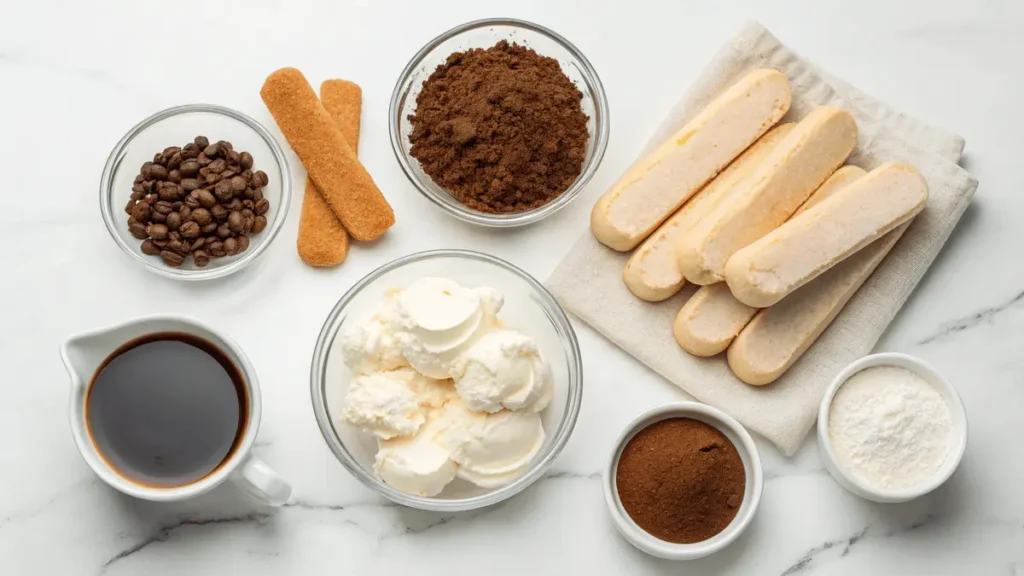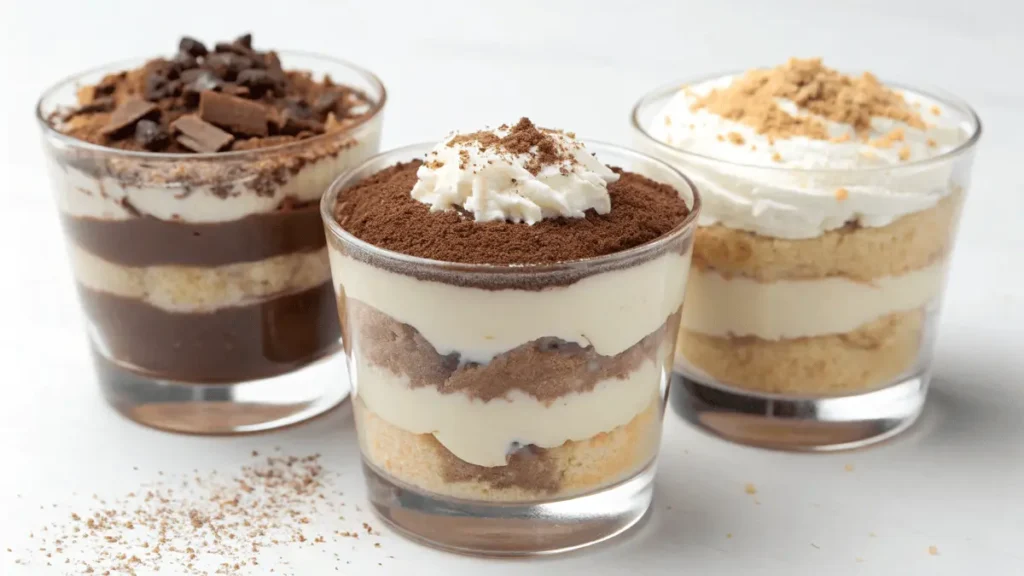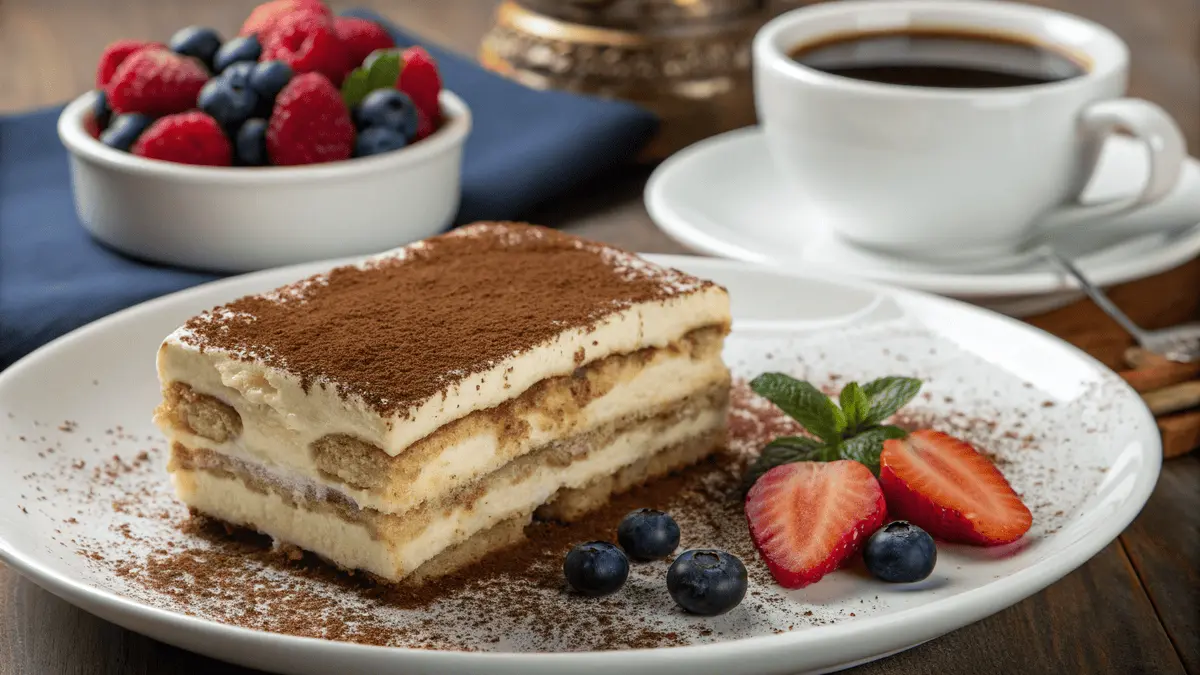When it comes to classic Italian desserts, Tiramisu is the undisputed queen. It’s got that perfect balance of rich creaminess, bold coffee flavor, and a soft, cakey texture thanks to ladyfingers soaked in espresso. In this guide, we’re diving deep into everything you need to know to make the best tiramisu recipe at home — no raw eggs, no baking, and absolutely no stress.
From a breakdown of simple, accessible ingredients to step-by-step layering instructions, you’ll have this dreamy dessert chilling in the fridge in no time. Whether you’re a total newbie in the kitchen or someone who’s cooked Italian Sunday dinners for decades, this guide is built to help you nail it every time.
So grab your mascarpone, espresso, and a little bit of patience (you’ll need to wait for it to chill!), and let’s whip up a dessert that’ll wow your guests and maybe even make your Nonna proud.
Table of Contents
What Is Tiramisu?
Tiramisu Definition and Meaning
The word tiramisu literally means “pick me up” in Italian — and honestly, it lives up to its name. This beloved dessert is a harmonious mix of espresso-soaked ladyfingers, luscious mascarpone cream, and a dusting of cocoa that gives it a kick of bitter-sweet elegance.
At its heart, a good tiramisu recipe balances bold coffee with a sweet, airy texture that melts in your mouth. It’s layered like a dream and served cold, which makes every bite refreshing and oh-so-satisfying.
Origins of the Traditional Italian Dessert
Tiramisu’s roots trace back to the Veneto region in Northern Italy, most likely in the 1960s or ’70s. Though the exact origin is debated (as with many iconic dishes), it’s widely accepted that it was first served in restaurants before becoming a household name across the globe.
What started as a simple, rustic dessert has now become a café classic. Thanks to its irresistible combination of creamy mascarpone, coffee, and cocoa, it’s one of those recipes that never go out of style.
Why This Is the Best Tiramisu Recipe
Modern Twist Without Raw Eggs
One thing that turns people off from many tiramisu recipes is the use of raw eggs. Sure, it’s traditional—but not everyone’s comfortable with that, and rightly so. That’s why this Tiramisu recipe takes a safer and creamier route. Instead of raw eggs, we’re using fresh whipped cream combined with mascarpone cheese to get that light, fluffy texture.
And guess what? You won’t miss the eggs one bit. In fact, most folks say they prefer this version because it’s silkier, richer, and far easier to make without the stress of raw ingredients.
No-Bake, Fuss-Free, Yet Rich in Flavor
Let’s face it—no one wants to be tied to the oven when making dessert. The beauty of this tiramisu is that it’s completely no-bake. Just layer it, chill it, and you’re done. Despite its simplicity, it doesn’t skimp on flavor. Thanks to the bold notes of espresso and coffee liqueur (if you choose to add it), each spoonful is packed with depth.
So if you’re looking for a tiramisu recipe that’s foolproof, comforting, and tastes like it came straight from an Italian café? You’re in the right place.
Tiramisu Ingredients Breakdown
Essential Ingredients: Mascarpone, Ladyfingers, Coffee

Every great Tiramisu recipe starts with just a handful of key ingredients. First up—ladyfingers. Also known as Savoiardi biscuits, these sponge-like cookies soak up coffee like a charm without falling apart.
Then there’s mascarpone cheese, the creamy heart of tiramisu. It’s thicker and richer than cream cheese, which gives the dessert that signature luxurious feel.
And of course, you’ll need strong espresso. Go bold here—it’s what gives tiramisu its lift (remember, “pick me up”?). Whether you brew a fresh shot or use instant espresso powder, the key is a deep, roasted flavor.
Don’t forget the cocoa powder! A generous dusting on top ties everything together with a slightly bitter edge that balances the sweet cream.
Optional Additions: Coffee Liqueur, Dark Rum, Marsala
Want to spice things up? A splash of coffee liqueur like Kahlúa adds warmth and depth. Or try dark rum or Marsala wine for a more classic twist. Not a fan of booze? No problem—skip it. Your tiramisu will still be amazing.
Ingredient Substitutions (Cream Cheese, Decaf Coffee, etc.)
No mascarpone in the fridge? You can sub in cream cheese, though it’ll be a bit tangier. Decaf espresso also works if you’re cutting back on caffeine. And while store-bought ladyfingers are easiest, some folks like to bake their own sponge cake base. Either way, you’ve got options—and they all lead to one sweet result.
Step-by-Step Tiramisu Recipe Instructions
Make the Mascarpone Cream Filling
First things first—let’s whip up that dreamy cream filling. In a mixing bowl, beat heavy whipping cream with sugar and vanilla extract until stiff peaks form. This step sets the base for that fluffy texture we all love. Once it’s firm, gently fold in mascarpone cheese until everything’s smooth, silky, and well combined.
Don’t overmix, though! The goal is to keep that light texture intact—so mix just enough to combine.
Dip the Ladyfingers the Right Way (Quick Tips)
Next up, prep your espresso (or strong coffee). If you’re using alcohol like coffee liqueur or Marsala wine, stir it in now. Pour the liquid into a shallow bowl. Then, working quickly, dip each ladyfinger into the mixture—just a second per side. You want them moist but not soggy.
Trust us: oversoaking turns your tiramisu into a mushy mess.
Layering the Dessert Like a Pro
Now, let’s build! In a baking dish (an 8×8″ pan works great), place a layer of dipped ladyfingers side-by-side. Spread half of your mascarpone mixture over them using a spatula. Smooth it out to the edges.
Repeat with another layer of dipped ladyfingers, followed by the remaining mascarpone cream. Take your time here—the better the layers, the more picture-perfect the final dessert.
Chill Time: Why It Matters
Cover your tiramisu and refrigerate it for at least 4 hours, though overnight is even better. This chill time allows all the flavors to blend beautifully.
Patience really does pay off here. The longer it rests, the more the espresso and cream infuse the layers with bold, decadent flavor.
Dusting & Garnishing Before Serving
Right before serving, dust the top generously with unsweetened cocoa powder using a fine mesh sieve. Want to jazz it up? Add chocolate curls, cocoa nibs, or even a sprinkle of instant espresso powder for extra flair.
For more delicious recipes, check out our recipe collection on Eppic Recipes.
Expert Tips for Authentic Tiramisu
Do’s and Don’ts When Dipping Ladyfingers
When making any Tiramisu recipe, how you dip the ladyfingers can make or break the dish. Do dip quickly—one second per side. Don’t let them soak, or you’ll end up with a soggy base.
Also, be consistent. If one side’s over-dipped and the other’s dry, you’ll get uneven texture. For best results, dip and layer as you go.
How to Get the Perfect Creamy Texture
Want your tiramisu to be cloud-like but rich? The key is to beat the cream until stiff peaks form before folding in the mascarpone. This helps trap air and keeps the cream light.
Also, always use room-temperature mascarpone. Cold cheese clumps, and clumps are the enemy of a smooth filling.
Make-Ahead and Storage Advice
Tiramisu is actually better when made ahead. The flavor deepens, the texture settles, and the layers hold together beautifully. You can make it up to two days in advance and store it in the fridge.
Leftovers? Keep them covered and chilled for up to three days. It also freezes well—just skip the cocoa dusting until you’re ready to serve.
Common Variations of Tiramisu

Alcohol-Free Version
Not everyone wants a boozy dessert—and that’s totally fine! One of the great things about this Tiramisu recipe is that it’s super flexible. You can easily skip the coffee liqueur without sacrificing flavor. Instead, use extra espresso or a splash of vanilla extract to keep the depth and richness.
This makes it perfect for family gatherings, especially when kids or non-drinkers are at the table.
Tiramisu Without Coffee (Kid-Friendly Option)
If coffee isn’t your thing (or you’re making dessert for little ones), you can swap out the espresso entirely. Try using hot chocolate milk, chai tea, or even milk with a touch of cocoa powder to dip the ladyfingers.
Sure, it won’t taste like a traditional tiramisu—but it’ll still be creamy, sweet, and layered with love.
Vegan or Dairy-Free Adaptations
Going dairy-free? Use coconut cream or plant-based whipped topping and swap mascarpone with vegan cream cheese. There are also eggless ladyfingers available online or in health food stores.
This way, you can still enjoy a dreamy tiramisu recipe, minus the dairy and guilt!
Nutritional Info & Serving Suggestions
Calories and Macronutrient Breakdown
Now let’s talk numbers—though this dessert is more about indulgence than counting calories. One serving of this tiramisu recipe contains around 290 to 330 calories, depending on ingredients and portion size. It’s rich in fats from the mascarpone and cream, moderate in carbs, and low in protein.
Want a lighter take? You can use low-fat whipped cream or swap in Greek yogurt for a protein boost.
Serving Size Tips
A small square goes a long way with tiramisu! Serve it chilled, straight from the fridge. Pair it with a tiny shot of espresso or a glass of sweet dessert wine to level up your experience.
Topping with fresh berries or a drizzle of chocolate syrup? Even better.
Frequently Asked Questions (FAQs)
Q: What is traditional tiramisu made of?
Traditional tiramisu is made with a few simple yet rich ingredients. These include ladyfingers (Italian sponge biscuits), strong espresso, mascarpone cheese, egg yolks, sugar, cocoa powder, and sometimes a splash of alcohol like Marsala wine or coffee liqueur. The classic Tiramisu recipe layers soaked ladyfingers with a creamy mascarpone and egg mixture, finishing with a dusting of cocoa powder.
Q: What alcohol is used in tiramisu?
The most commonly used alcohol in a traditional tiramisu is Marsala wine. However, many modern Tiramisu recipes also use coffee liqueurs such as Kahlúa, Tia Maria, or even dark rum or brandy. Each adds a unique twist, enhancing the dessert’s rich coffee flavor.
Q: What are ladyfingers soaked in for tiramisu?
Ladyfingers are typically soaked in strong espresso or brewed coffee. For added depth, many Tiramisu recipes mix the coffee with a bit of coffee liqueur or Marsala wine. It’s important to dip them briefly—just a quick in-and-out—so they stay soft but don’t fall apart.
Q: How to make a classic tiramisu?
To make a classic Tiramisu recipe, start by whipping egg yolks with sugar, then gently folding in mascarpone cheese. In a separate bowl, whip egg whites or heavy cream until stiff and fold that into the mascarpone mix.
Next, briefly dip ladyfingers in espresso (mixed with liqueur if desired) and layer them in a dish. Add a layer of the mascarpone cream, then repeat with more soaked ladyfingers and cream. Finish with a generous dusting of unsweetened cocoa powder. Chill for several hours before serving to let the flavors meld.
Related Desserts You’ll Love
Classic Italian Desserts: Cannoli, Panna Cotta
Love the creamy goodness of tiramisu? You might fall head over heels for cannoli. These crispy pastry tubes filled with sweet ricotta are a Sicilian classic. Or try panna cotta—a silky custard-like dessert that’s elegant, easy, and just as dreamy.
Each offers that signature Italian sweetness without needing hours in the kitchen.
Other No-Bake Favorites: Cheesecake Jars, Icebox Cakes
If no-bake desserts are your jam, you’ll want to check out cheesecake jars—personal-sized treats layered with creamy filling and cookie crumbs. Super cute and perfect for parties!
Icebox cakes are another crowd-pleaser. They rely on layering cookies and cream, then chilling until everything softens into a cake-like texture. Like this tiramisu recipe, they’re proof that you don’t need an oven to make something amazing.
For more delicious treats, explore our full collection of easy dessert recipes at Eppic Recipes.
Final Thoughts – Why You’ll Love This Tiramisu
This Tiramisu recipe checks every box—it’s rich, creamy, bold, and surprisingly easy to make. With no baking, no raw eggs, and flexible ingredients, it’s a go-to dessert that fits almost any occasion. Whether you’re hosting a fancy dinner or just want to treat yourself on a cozy night in, this dessert delivers big flavor with minimal fuss.
Plus, it’s make-ahead friendly, which means less stress and more time to enjoy. One spoonful in, and you’ll understand why this timeless treat continues to win hearts around the world. So go on—grab a fork and dig in. You’ve earned it.

